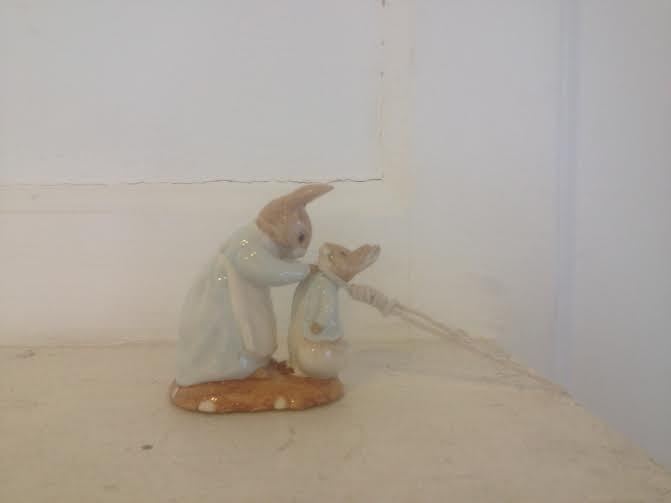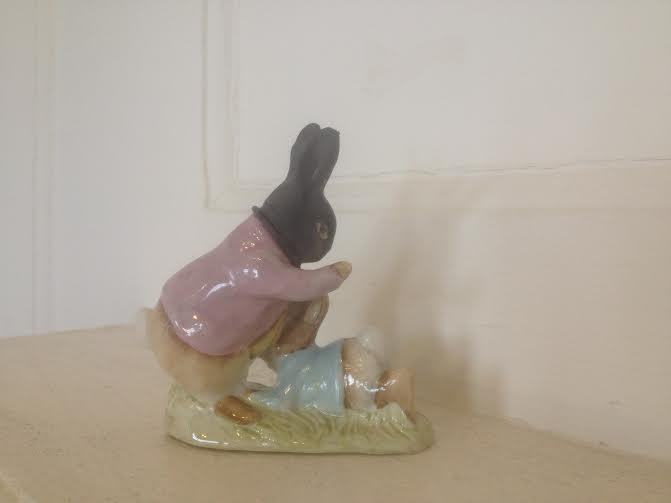Karen Densham approaches the making of art with a broad brush. Her choices of materials and techniques are various and include ceramics, video, drawing, and photography. This breadth results in an output that could at first glance be seen to have a bewildering range, although on further inspection, consideration and assimilation, a common purpose can be discovered to be at play.
Much of Karen’s work challenges our assumptions and presumptions about the world around us. Our tendency to anthropomorphise, our inclination towards the ‘cute’ and ‘pretty’, our desire for the bucolic, and the way in which we seek the ‘cosy’ or sentimental side of life, are useful departure points for some of Karen’s works to react against, turning expectations around in a way that can surprise or shock, and encouraging us to re-examine our value systems and judgements.
Common cultural elements are taken as found objects (often sourced from car-boot sales, charity shops or e-bay) and adapted in subtle ways to alter their character and being. These slight adjustments can draw out uncommon relationships and connections within the common-place. A photograph documents a decorative ceramic shire horse with a leg that has been broken off and substituted by a small head of broccoli, while the horse gazes at a larger head of broccoli. The smaller piece of broccoli draws connections between it and the shire-horse’s broad hair-covered hooves, while the larger one suggests a similarity between the structure and form of broccoli and that of trees (Thomas Gainsborough (1727-88) used to construct miniature landscapes using mirrors for water, coal for rocks and broccoli for trees). The resulting image is surreal in both its choice of replacement object and its play with scale.
Some of the transformations have a more sinister or anarchic edge to them. A pair of ceramic characters showing old Mr Benjamin Bunny (from a Beatrix Potter tale) smacking his son has been altered by applying a black rubber mask to the spanker. The scene now suggests an act of sexual gratification through a sadistic and masochistic exchange rather than a once banal but now out-dated depiction of a father punishing his child (although the fact that the protagonists are both rabbits throws another element of transgression into the mix).
Rabbits feature again in the form of a pregnant rabbit with a distressed effect gold leaf covering, similar to a chocolate Easter bunny, although the clear bump of pregnancy combined with the apparently decaying wrapper makes the thought of unwrapping and consuming the item slightly unsavoury. There is also a collection of cast clay duck-rabbits (a form that can either be seen as a duck or a rabbit that was made famous by Ludwig Wittgenstein as a representation of a duality of seeing and meaning) which seems particularly appropriate, as double-meaning is perhaps something that is imbued in many of Karen’s works. A selection of watercolours presents adaptations of Beatrix Potter’s illustrations, but with their own sinister twist.
Karen’s interrogation and enquiry into the potential subversion of an object extends into the use of the language that surrounds that object. Her press-moulds of ceramic chickens with their heads removed number a half-dozen, all facing different directions and looking as scattered and disorganised as you might expect a flock of headless chickens to. Under a toy piano with the label “Grand Piano” upon it, sleeps a small white elephant, perhaps questioning the usefulness of its own being, as the combination of objects works to give off a slightly pathetic quality suggestive of redundancy and ridiculousness. The title Baby Grand connects the two seemingly unconnected elements (a very baby elephant with a very baby grand piano) and the more sinister connection of ebony and ivory (perhaps symbolised by the black of the piano and the white of the elephant) is underlying. These visual puns are presented in an understated manner – there for the finding rather than being boldly emblazoned.
The world of works that Karen has created sullies the niceties of the more comforting and homely side of life as evidenced in domestic ceramic figurines, reminding us that there is a sinister and darker side out there, waiting in the wings. Another pivotal piece (of two halves) takes a damaged (the head has broken off) ceramic statue of Marie Antoinette, a typical mantelpiece ornament, and replaces the missing head with a French Fancy cake (which also gives the title for the work). The missing head is placed on a small turntable in a work titled Revolution. The duality of the works and the connection to revolt again suggest connections and threads across Karen’s works that are not immediately apparent.
Kaavous Clayton. 2015
Sense and Non Sense ( extract from Minories Catalogue)
To borrow from Keith Arnatt: Karen Densham is a real artist.
She is an instinctive, original, lateral thinker, allied to a kind of innocence ( artist’s have to both innocent and experienced).
When Armegeddon strikes and invention and resourcefulness are a requirement for survival, I will be seen clinging to her, offering myself up as her assistant. Her practical intelligence and conceptual fluidity is an argument for John Latham’s Artist Placement Group, in which artist’s were to take up temporary residence in areas of industry where they could bring a fresh interpretation to bear on habitualised thinking.
At the risk of daring to smite one of my fathers – indeed the very God of art’s present paradigm – when Duchamp spoke of wishing to rid the association of the artist with the phase “ as stupid as a painter” he revealed his yearning for bourgeois respectability. I would argue that the origin of the notion of the artist’s stupidity is rooted in the alternative mindset that the Artist / Court Jester / Fool / Lateral thinker inhabits. In the most mundane context (the workplace springs to mind) interpreting events differently can be regarded as a bit daft, and allowed expression only in the form of humour, while in a more permissive context it can be seen as refreshingly creative. Perhaps the young Marcel – the product of bourgeois parents – had been made to feel embarrassed for some lateral thoughts he expressed: “ Dear father forgive me for I have sinned, I’ve been having lateral thoughts.”
Put together over the relatively short period of the last 4 months (lively minds work best this way) this body of work utilizes all the great qualities listed above. They are formally strong poetic objects conjured out of scant resources quickly thrown together. And it is only their poetry that ultimately matters i.e. how effectively they work as artworks (whatever their subject matter, or lack of) – the extent to which they hold us, the existential event ( and it’s memory) that viewing a visual work of art provides.
Terry Bond, 2015
Karen Densham’s plates have an individual quality of paintings. Each has its drawn image (usually a horse, sometimes a bird or a human being) in the centre, and the line has a rubbed-out and washed-over quality. The plate as a whole looks like a gouache worked over and run under a tap. The effect is to make the central images appear to be in an ambiguous space, and to convey the mental image that arises when one half remembers what a person or animal looked like. The plates are, therefore, poignant: they suggest the struggle to hold on to the memory of something or someone that is valuable. This is a personal impression. Behind the creation of these plates, there is a sort of game going on that is very much of its time – very Lisson Gallery and neo – conceptual. It goes like this. Each series of plate in the exhibition used an image taken from a museum catalogue or a pottery textbook. So, the same horse taken from a Staffordshire pottery design appears through a series called Racing Certainties. The colouring and the ground of each plate are, however different. Each plate also has a name; just as each horse has its name over the stable door, each plate has its name incised at the top . It is an echo of the decorative plate tradition, but the titles are also intended to suggest ironic reference to aspects of being a contemporary potter. Hence the link with contemporary art. – this is pottery which, though decorative in its own right, it is also making the business of being a studio potter part of its subject matter. Some will find this approach to be overly self-conscious; others will accept that every artist craftsperson has to construct a strategy and a framework for him or herself. Some people will be amused and engaged by the game. I am not bothered one way or another by the content, but I do enjoy the poignancy of the images, and the careful balance between a kind of lumpenness and finesse that I think characterises these works. Karen Densham wants to make plates that have a poetry and in several instances, I think that she has succeeded.
Peter Domer (extract) 1993.
Karen Densham at The Minories
Being reasonably new to the Essex Art’s scene, having only recently moved back, I was surprised to find how much was going on in my area and not just by amateur landscape watercolour enthusiasts but by real, interesting, contemporary artists. How very exciting I thought to myself! So, on one of my weekly trips to Colchester to eat cake and soak up a change of scenery I had a little mooch around The Minories and took in Karen Densham’s exhibition, Form and Dysfunction. Her medium is vast, encompassing ceramics, film, photography and sculpture. She has exhibited in many of London’s major galleries, including the V&A and studied at The Royal Collage of Art and Wolverhampton Polytechnic.
Densham’s satirical take on kitsch, questions our perceptions and relationships with objects and in turn the kinds of people whom might enjoy such items. Seemingly harmless porcelain figurines have been transformed to become sinister and displaced items. It is interesting to see how a simple object can become something else when altered (even slightly) and when viewed out of context the object can develop new meaning and deliver an alternative message.

Karen Densham, Choker, 2014
I can’t help but think that Densham is also making clever observations about the bourgeoisie and the ideals/lifestyle they choose. All is not quite so civilised and rosy as we might be led to believe in suburbia. She makes reference to death and murder (or assisted suicide?), a figure of a rabbit is given a hangman’s hood, another a noose and a helping…paw. Headless chickens reminiscent of the kind found in souvenir shops in Spain and Portugal stand confused in a corner, a Lego wall divides two golden statues of children, a miniature piano and beneath it small mould of an elephant. I try to recall the elephant and piano, I’m sure there is a joke about it but I can not remember. These objects are almost painfully British and familiar, representative of the middle classes in the 70′s and 80′s and as comfortable and common as Tupperware. Densham plays on our existing notions and knowledge of these items and then distorts them, leaving us to question if we ever really knew what they meant in the first place.
Suzie Silk. 2015

Karen Densham, Gimp, 2014